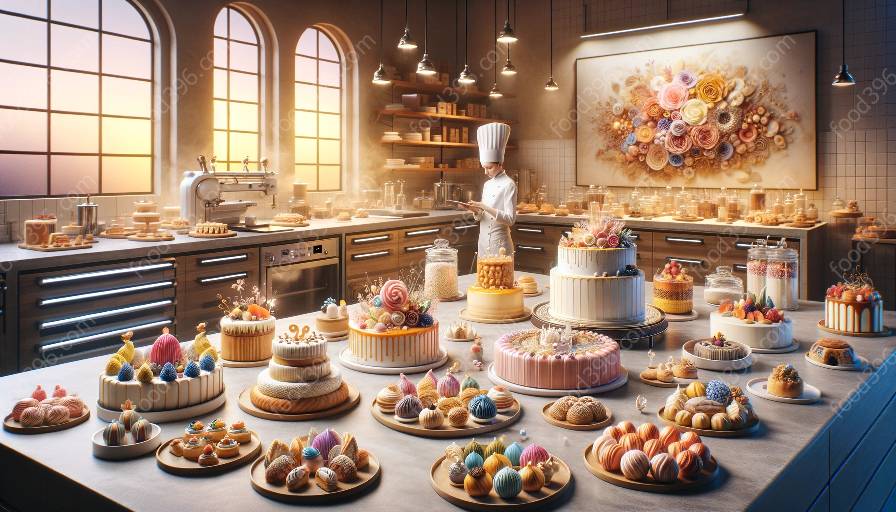Shortcrust pastry is a fundamental component in the world of baking, and mastering the techniques behind its creation is essential for any aspiring pastry chef. This guide will delve into the art of shortcrust pastry, exploring its intersection with pastry arts, decorative techniques, and baking science & technology.
Understanding Shortcrust Pastry
Shortcrust pastry, also known as pie or tart crust, is a versatile and widely used pastry dough that forms the base for countless sweet and savory baked goods. Its simplicity lies in the combination of just a few key ingredients – flour, fat, liquid, and sometimes sweeteners or flavorings.
To achieve the perfect shortcrust pastry, understanding the various techniques involved is crucial. Let's explore the key components and methods essential for creating delectable shortcrust pastry.
Ingredients:
- Flour: The choice of flour greatly influences the texture of the pastry. Plain or all-purpose flour is a common choice, but recipes may call for specialty flours like pastry flour or even whole wheat flour for added depth of flavor.
- Fat: Butter, lard, or shortening are the most commonly used fats in shortcrust pastry. Each imparts a unique flavor and texture to the final product. The fat needs to be cold and cut into the flour to create a crumbly texture.
- Liquid: Water is the typical liquid used in shortcrust pastry, with some recipes incorporating other liquids such as milk or eggs for added richness.
- Sweeteners or Flavorings: Depending on the desired outcome, sugar, salt, and flavorings like vanilla extract or citrus zest may be added to the pastry dough.
Techniques:
- Blending the Ingredients: The primary technique in creating shortcrust pastry is achieving the perfect blend of the dry ingredients with the fat. This is often done by cutting or rubbing the fat into the flour until the mixture resembles coarse breadcrumbs.
- Adding the Liquid: Once the fat and flour are combined, the liquid is added gradually to bring the dough together. Care must be taken not to overwork the dough, as this can lead to a tough final product.
- Resting and Chilling: Allowing the pastry to rest in the refrigerator before rolling it out allows the gluten in the flour to relax, resulting in a more tender and flaky crust.
- Rolling and Shaping: Proper rolling techniques are essential to achieving the desired thickness and shape for the pastry. Whether lining a tart tin or creating a lattice top for a pie, precision is key.
- Baking: The final step in the process, baking the shortcrust pastry requires attention to detail regarding temperature and timing to achieve a crisp and golden crust.
Pastry Arts and Decorative Techniques
Shortcrust pastry serves as a canvas for creative expression within the realm of pastry arts. The versatility of this dough allows pastry chefs to showcase their decorative skills through techniques such as crimping, latticing, and blind baking.
Crimping:
When creating a pie or tart, the edges of the shortcrust pastry can be crimped in various styles to add visual appeal. From simple fluting to intricate designs, crimping elevates the presentation of the final product.
Latticing:
Latticing involves weaving strips of pastry to create a decorative top for pies or tarts. This technique not only adds visual interest but also allows steam to escape during baking, preventing a soggy bottom crust.
Blind Baking:
For certain types of pies and tarts, blind baking the shortcrust pastry is required before adding the filling. This process involves partially or fully baking the pastry without the filling to ensure a crisp and flaky base.
Mastering these techniques requires not only skill but also a keen understanding of the properties of shortcrust pastry and how it responds to different methods of manipulation.
Baking Science & Technology
Behind every perfectly baked piece of shortcrust pastry lies the principles of baking science and technology. From the chemical reactions that occur during mixing to the precise control of oven temperature, science plays a crucial role in the creation of exceptional pastry.
Gluten Formation:
Understanding the formation of gluten in the pastry dough is essential for achieving the desired texture. Overworking the dough can lead to excessive gluten formation, resulting in a tough and chewy crust. Proper technique and handling ensure a tender and flaky outcome.
Leavening:
Depending on the recipe, leavening agents like baking powder or baking soda may be incorporated to add a light and airy texture to the pastry. The interaction of these agents with other ingredients is a precise science that impacts the final baked product.
Oven Dynamics:
Controlling oven temperature and heat distribution is vital for achieving uniform baking. Understanding the behavior of shortcrust pastry in the oven allows bakers to make adjustments for the perfect browning and textural characteristics.
Moisture Management:
Balancing the moisture content in the pastry dough is crucial for its texture and structure. Factors such as the fat content, liquid-to-flour ratio, and hydration level all contribute to the final result.
Baking science and technology not only provide insights into the underlying processes of pastry creation but also empower bakers to innovate and troubleshoot to achieve the ideal finished product.
Conclusion
Shortcrust pastry is a cornerstone of the baking world, and mastering its techniques is an art form that harmonizes pastry arts, decorative techniques, and baking science & technology. By understanding the essential components and methods of shortcrust pastry, along with its creative and scientific applications, aspiring pastry chefs can elevate their skills and unleash their culinary creativity.


